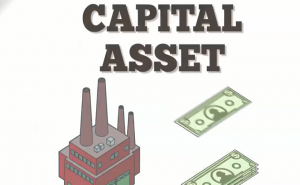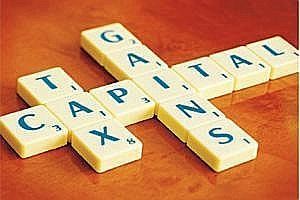In this blog post, Varun Chauhan, an Associate at Dhir and Dhir Associates, New Delhi with the Corporate Advisory and Loan Structuring Team who is currently pursuing a Diploma in Entrepreneurship Administration and Business Laws from NUJS, Kolkata, deliberates on whether the benefit of Indexation is available while computing Capital Gain arising on transfer of Short-Term Capital Asset.
Before discussing the primary question on availability of benefit of indexation, it is important to apprise ourselves of some key terms and concepts that are going to appear in the forthcoming deliberation.
Key terms
Capital Asset:
A capital asset is a type of asset that is not easily sold in the regular course of a business’s operations for cash and is owned for its role in contributing to the business’s ability to generate profit.[1]
Section 2(14) of The Income Tax Act, 1995 further defines Capital Asset as:
“Capital Asset” means property of any kind held by an assessee, whether or not connected with his business or profession, but does not include-
- any stock-in-trade, consumable stores or raw materials held for his business or profession;
- For personal effects, that is to say, movable property (including wearing apparel and furniture, but excluding Jewellery) held for personal use by the assessee or any member of his family dependent on him.
Explanation – for this sub-clause, “Jewellery” includes-
- Ornaments made of gold, silver, platinum or any other precious metal or any alloy containing one or more of such precious metals, whether or not containing any precious or semiprecious stone, and whether or not worked or sewn into any wearing apparel;
- Precious or semi- precious stones, whether or not set in any furniture, utensil or other article or worked or sewn into any wearing apparel;
- Agricultural land in India, not being land situated –
- In any area which is comprised within the jurisdiction of a municipality (whether known as a municipality, municipal corporation, notified area committee, town area committee, town committee, or by any other name) or a cantonment board and which has a population of not less than ten thousand according to the last preceding census of which the relevant figures have been published before the first day of the previous year; or
- in any area within such distance, not being more than eight kilometres, from the local limits of any municipality or cantonment board referred to in item (a), as the Central Government may, having regard to the extent of, and scope for, urbanisation of that area and other relevant considerations, specify in this behalf by notification in the Official Gazette;
- 5 per cent Gold Bonds, 1977, or 7 per cent Gold Bonds, 1980, or National Defence Gold Bonds, 1980, issued by the Central Government;
- Special Bearer Bonds, 1991, issued by the Central Government;
- Gold Deposit Bonds issued under the Gold Deposit Scheme, 1999 or deposit certificates issued under the Gold Monetisation Scheme, 2015.
Capital Gain:
Any gain/profit that is derived after disposing of/transferring a Capital Asset is known as Capital Gain. Such income in the form of gain/profit is taxable under Indian laws (Income Tax Act, 1995) under the head ‘Capital Gains’.
Categorization of Capital Assets as Short Term and Long Term:
For the purpose of taxation, Capital Assets are usually segregated by their period of holding. Any Capital Gain derived from their disposal is taxed accordingly. The minimum period of holding for declaring a Capital Asset as Long Term depends on upon the nature of the underlying asset. Otherwise, a Capital Asset is deemed as Short Term Capital Asset and taxed accordingly. The following Table[2] shows the segregation based on the period of holding for different categories of Capital Assets:
| Nature of Capital Asset | Minimum period of holding (to be termed as Long Term) |
| Listed Shares (equity and preferential) | 1 year |
| Unlisted Shares (equity and preferential) | Two years[3] |
| Physical Gold and e-Gold | 3 years |
| Gold ETF Bonds and Gold Mutual Funds | 3 years |
| Other Listed Securities [debentures (including NCD), units of UTI, Government securities, and Zero Coupon Bonds, etc.] | 1 year |
| Other Unlisted Securities [debentures (including NCD), units of UTI, Government securities, and Zero Coupon Bonds, etc.] | 3 years |
| Real Estate Property | 3 years |
| Units of equity oriented funds | 1 year |
| Debt funds (whether quoted or not) | 3 years |
Indexation and Cost Inflation Index:
Indexation is a technique to create a proportionate balance between the taxable incomes (capital gain) with the current rate of inflation. As the capital gain/profit is taxable, the technique of indexation provides a level playing field to an assessee so that only real component of his income (capital gain) is taxed. For this purpose, Government has prepared a Cost Inflation Index (CII) taking Financial Year 1981-82 as the base year. Every year Government updates the CII for taxation purposes. Following is the CII[4] updated till 2016-17:
| Financial Year | CII | Financial Year | CII |
| Before 1/4/1981 | 100 | 1985-86 | 133 |
| 1981-82 | 100 | 1986-87 | 140 |
| 1982-83 | 109 | 1987-88 | 150 |
| 1983-84 | 116 | 1988-89 | 161 |
| 1984-85 | 125 | 1989-90 | 172 |
| 1990-91 | 182 | 2004-05 | 480 |
| 1991-92 | 199 | 2005-06 | 497 |
| 1992-93 | 223 | 2006-07 | 519 |
| 1993-94 | 244 | 2007-08 | 551 |
| 1994-95 | 259 | 2008-09 | 582 |
| 1995-96 | 281 | 2009-10 | 632 |
| 1996-97 | 305 | 2010-11 | 711 |
| 1997-98 | 331 | 2011-12 | 785 |
| 1998-99 | 351 | 2012-13 | 852 |
| 1999-00 | 389 | 2013-14 | 939 |
| 2000-01 | 406 | 2014-15 | 1024 |
| 2001-02 | 426 | 2015-16 | 1081 |
| 2002-03 | 447 | 2016-17 | 1125 |
| 2003-04 | 463 |
Indexed Cost of Acquisition:
Indexed Cost of Acquisition (ICA) is calculated to defeat the effects of inflation on your Capital Gain. This method, as already discussed, helps to achieve the real motive behind taxing the income of a person. As inflation engulfs a large portion of a person’s returns from different investments (by reducing the purchasing power of money), it becomes all the more important to chalk out a policy to minimize this risk of paying enormous unjustified tax on Capital Gains so that only real Capital Gain can be taxed. With the help of CII, Indexed Cost of Acquisition (ICA) can be ascertained as follows for computing Indexed Capital Gain:
ICA = Cost of Acquisition of Capital Asset * CII of the year of Transfer/CII of the year of Acquisition
Tax Scheme for Capital Gains
The benefit of Indexation discussed in the preceding paragraphs, is available only to the Long Term Capital Gain Transactions i.e. where a person has earned some profit/gain on disposing/transferring a Long Term Capital Asset. This benefit is not available in transactions involving transfer/disposal of Short Term Capital Assets.
The rationale behind this rule is to revamp investment sentiment in the economy. By providing the benefit of Indexation only to the Long Term Capital Gain Transactions, Government ensures that people invest in the Capital assets for a comparatively longer period, thereby infusing steady money into the economy. Therefore, Indexation acts as an incentive for taxpayers and ultimately results in more money being pooled in for more productive endeavors.
Tax rates for Short Term Capital Gain (STCG) are higher than the tax rates for Long Term Capital Gain (LTCG). Moreover, tax amount in LTCG cases further reduces because ICA (derived after using CII) is deducted from the Total Consideration Value of the underlying Capital Asset to calculate the Indexed Capital Gain (ICG). The ICG is used for assessing Long Term Capital Gain Tax.
Illustration:
Mr. A acquires a plot of land for Rs 10000 on 21st June 2010. He sells that land on 20th February 2015 for Rs 15000. Apparently, his non-indexed Capital Gain amounts to Rs 5000 (15000-10000). But Mr. A can take benefit of Indexation as his period of holding is more than three years (as the minimum period of holding for real estate asset is three years). For calculating ICG of Mr. A, we need to ascertain his Indexed Cost of Acquisition (ICA) by applying the formula mentioned in the preceding paragraph i.e.:
ICA = 10000 * 1024/711 = 14402.25
Therefore ICG of Mr. A amounts to:
Total Consideration Received (15000) – ICA (14402.25)
= Rs 597.75
Mr. A needs to pay his Capital Gain Tax on his ICG of Rs.597.75 only, instead of Non Indexed Capital Gain of Rs.5000.
An assessee can take the benefit of Indexation if he makes Capital Gain on his Long Term Capital Asset. Earlier, he also had the option to choose if he wants to use this benefit or not in certain circumstances, but now this practice has been done away. The following Table shows current tax rates for both the categories of Capital Gain Transactions:
| Nature of Capital Gain | Tax Rate | |
| LTCG | 1. On Shares (equity and preferential)
2. On Other Capital Assets
|
NIL
20% with Indexation Benefit |
| STCG | 1. On Shares (equity and preferential)
2. On Other Capital Assets |
15%
Added to Income of Assessee and taxed as per his Income Tax Slab Rate. |
Therefore, any LTCG transaction can avail the benefit of Indexation which lowers the taxable amount of Capital Gain earned in that transaction. In this manner, the assessee is relieved of the tax burden to a great extent. And sometimes even the tax liability becomes nil when the Indexed Cost of Acquisition (ICA) amounts to a greater value than the actual sale consideration.
However, such benefit is not available to any STCG transaction. Any STCG is added to the income of the assessee and taxed according to his Income Tax Slab Rate only.
Footnotes:
[1]Definition given by Investopedia, Can be reached at:
Http://www.investopedia.com/terms/c/capitalasset.asp?layout=infini&v=5F&adtest=5F&ato=0 last visited on 20th June 2016.
[2] Data borrowed from Income Tax Department Tutorial ‘Tax On Long-Term Capital Gains’, Can be reached at http://www.incometaxindia.gov.in/Tutorials/15-%20LTCG.pdf , last visited on 22nd June 2016.
[3] With effect from the assessment year 2017-18 onwards. Currently, it is three years.
[4] As taken from the Website of Income Tax Department, Government of India, Can be reached at http://www.incometaxindia.gov.in/Pages/charts-and-tables.aspx, Last visited on 22nd June 2016.
 Serato DJ Crack 2025Serato DJ PRO Crack
Serato DJ Crack 2025Serato DJ PRO Crack













 Allow notifications
Allow notifications



